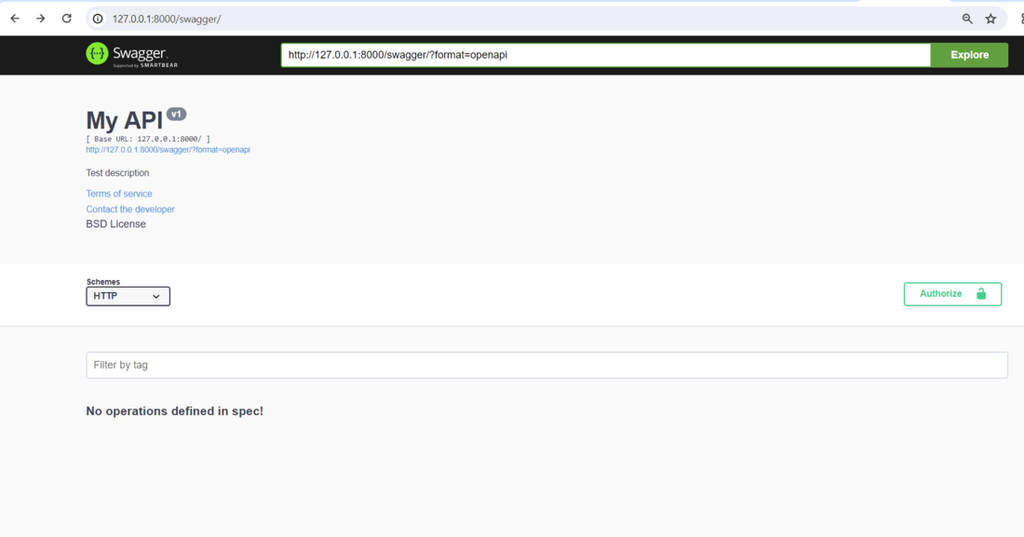Swagger Integration with Python Django
Last Updated : 11 May, 2024
Integrating Swagger with Django REST Framework can be quite useful for documenting and testing your API. One popular tool for integrating Swagger with Django REST Framework is drf-yasg (Yet Another Swagger Generator). In this article, we will see how to integrate Swagger with the Django REST framework.
Swagger Integration With Python Django
Below is the step-by-step procedure by which we can integrate swagger with the Django REST framework using Python:
Starting the Project Folder
To start the project use this command
django-admin startproject core cd core
To start the app use this command
python manage.py startapp home
Now add this app to the ‘settings.py’
INSTALLED_APPS = [ 'django.contrib.admin', 'django.contrib.auth', 'django.contrib.contenttypes', 'django.contrib.sessions', 'django.contrib.messages', 'django.contrib.staticfiles', 'home', 'rest_framework', 'drf_yasg', ]
install restframework and drf_yasg
pip install drf-yasg pip install djangorestframework
File Structure

core/settings.py: This code configures Swagger settings for Django REST Framework API, specifying a Bearer token security definition and disabling session-based authentication. Add below code in settings.py for swagger integration:
Python SWAGGER_SETTINGS = { 'SECURITY_DEFINITIONS': { 'Bearer': { 'type': 'apiKey', 'name': 'Authorization', 'in': 'header' } }, 'USE_SESSION_AUTH': False, } home/swagger.py: Create swagger.py file and add the below code. This code sets up a Swagger schema view for the Django REST Framework API, defining metadata such as title, version, description, terms of service, contact, and license. It allows public access and permits any user to view the schema.
Python from rest_framework import permissions from drf_yasg.views import get_schema_view from drf_yasg import openapi schema_view = get_schema_view( openapi.Info( title="My API", default_version='v1', description="Test description", terms_of_service="https://www.google.com/policies/terms/", contact=openapi.Contact(email="contact@myapi.local"), license=openapi.License(name="BSD License"), ), public=True, permission_classes=(permissions.AllowAny,), )
home/urls.py: This Django code imports the admin module for administrative tasks, defines URL patterns for the admin interface and Swagger documentation. The schema_view is imported from a module named swagger, and it's used to render the Swagger UI for API documentation at the '/swagger/' endpoint with zero caching.
Python from django.contrib import admin from django.urls import path from home.swagger import schema_view urlpatterns = [ path('admin/', admin.site.urls), path('swagger/', schema_view.with_ui('swagger', cache_timeout=0), name='schema-swagger-ui'), ] Deployment of the Project
Run these commands to apply the migrations:
python3 manage.py makemigrations python3 manage.py migrate
Run the server with the help of following command:
python3 manage.py runserver
Output
 Swagger Integration With Django
Swagger Integration With Django
Similar Reads
Python Tutorial - Learn Python Programming Language Python is one of the most popular programming languages. It’s simple to use, packed with features and supported by a wide range of libraries and frameworks. Its clean syntax makes it beginner-friendly. It'sA high-level language, used in web development, data science, automation, AI and more.Known fo
10 min read
Python Interview Questions and Answers Python is the most used language in top companies such as Intel, IBM, NASA, Pixar, Netflix, Facebook, JP Morgan Chase, Spotify and many more because of its simplicity and powerful libraries. To crack their Online Assessment and Interview Rounds as a Python developer, we need to master important Pyth
15+ min read
Non-linear Components In electrical circuits, Non-linear Components are electronic devices that need an external power source to operate actively. Non-Linear Components are those that are changed with respect to the voltage and current. Elements that do not follow ohm's law are called Non-linear Components. Non-linear Co
11 min read
Python OOPs Concepts Object Oriented Programming is a fundamental concept in Python, empowering developers to build modular, maintainable, and scalable applications. By understanding the core OOP principles (classes, objects, inheritance, encapsulation, polymorphism, and abstraction), programmers can leverage the full p
11 min read
Python Projects - Beginner to Advanced Python is one of the most popular programming languages due to its simplicity, versatility, and supportive community. Whether you’re a beginner eager to learn the basics or an experienced programmer looking to challenge your skills, there are countless Python projects to help you grow.Here’s a list
10 min read
Python Exercise with Practice Questions and Solutions Python Exercise for Beginner: Practice makes perfect in everything, and this is especially true when learning Python. If you're a beginner, regularly practicing Python exercises will build your confidence and sharpen your skills. To help you improve, try these Python exercises with solutions to test
9 min read
Python Programs Practice with Python program examples is always a good choice to scale up your logical understanding and programming skills and this article will provide you with the best sets of Python code examples.The below Python section contains a wide collection of Python programming examples. These Python co
11 min read
Spring Boot Tutorial Spring Boot is a Java framework that makes it easier to create and run Java applications. It simplifies the configuration and setup process, allowing developers to focus more on writing code for their applications. This Spring Boot Tutorial is a comprehensive guide that covers both basic and advance
10 min read
Python Introduction Python was created by Guido van Rossum in 1991 and further developed by the Python Software Foundation. It was designed with focus on code readability and its syntax allows us to express concepts in fewer lines of code.Key Features of PythonPython’s simple and readable syntax makes it beginner-frien
3 min read
Python Data Types Python Data types are the classification or categorization of data items. It represents the kind of value that tells what operations can be performed on a particular data. Since everything is an object in Python programming, Python data types are classes and variables are instances (objects) of thes
9 min read